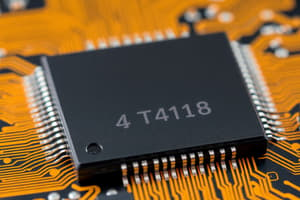Podcast
Questions and Answers
What is the primary function of a Voltage Follower in an Op-amp circuit?
What is the primary function of a Voltage Follower in an Op-amp circuit?
- It produces a zero crossing detection.
- It compares two different voltages.
- It outputs a voltage that follows the input voltage. (correct)
- It amplifies the input voltage.
Which of the following is a characteristic feature of an Inverting Amplifier?
Which of the following is a characteristic feature of an Inverting Amplifier?
- It produces an output that is out of phase by 90 degrees.
- It has a voltage gain equal to 2.
- It produces an output that is out of phase by 180 degrees. (correct)
- It reflects the same phase as the input.
What advantage does a Voltage Follower provide to the circuit it is part of?
What advantage does a Voltage Follower provide to the circuit it is part of?
- Increases the voltage output significantly.
- Takes significant current from the input.
- Provides power gain and current gain. (correct)
- Has high output impedance.
What type of output does a Differentiator circuit produce for a steadily changing input voltage?
What type of output does a Differentiator circuit produce for a steadily changing input voltage?
How does a Voltage Comparator function in terms of the voltages it receives?
How does a Voltage Comparator function in terms of the voltages it receives?
What characterizes a bistable flip-flop?
What characterizes a bistable flip-flop?
What is the role of an Anti-Logarithmic Amplifier?
What is the role of an Anti-Logarithmic Amplifier?
Which component is used to convert analog signals into digital signals?
Which component is used to convert analog signals into digital signals?
What does the resolution of an ADC indicate?
What does the resolution of an ADC indicate?
What does a Zero Crossing Detector specifically detect?
What does a Zero Crossing Detector specifically detect?
What type of reference voltage can be applied to an Op-amp circuit?
What type of reference voltage can be applied to an Op-amp circuit?
What is the unit of sampling frequency for an ADC?
What is the unit of sampling frequency for an ADC?
What is the effect of a higher sampling frequency on sound quality?
What is the effect of a higher sampling frequency on sound quality?
Which type of ADC is known for being the most inexpensive?
Which type of ADC is known for being the most inexpensive?
What is the primary function of a differential amplifier?
What is the primary function of a differential amplifier?
Which of the following devices is known to perform mathematical operations in signal processing?
Which of the following devices is known to perform mathematical operations in signal processing?
What is a primary function of microcontrollers in mixed-signal technologies?
What is a primary function of microcontrollers in mixed-signal technologies?
Which type of sensor requires an external excitation signal?
Which type of sensor requires an external excitation signal?
Which of the following is NOT an application of a voltage follower?
Which of the following is NOT an application of a voltage follower?
What characteristic describes linear applications of Op-Amps?
What characteristic describes linear applications of Op-Amps?
What distinguishes passive sensors from active sensors?
What distinguishes passive sensors from active sensors?
Which of the following components is primarily used for interfacing with external environments in mixed-signal systems?
Which of the following components is primarily used for interfacing with external environments in mixed-signal systems?
What is the main purpose of a voltage follower in a circuit?
What is the main purpose of a voltage follower in a circuit?
In which type of application do op-amps exhibit a non-linear relationship between input and output?
In which type of application do op-amps exhibit a non-linear relationship between input and output?
What does the duty cycle represent in relation to clock signals?
What does the duty cycle represent in relation to clock signals?
Which of the following is a characteristic feature of the instrumentation amplifier?
Which of the following is a characteristic feature of the instrumentation amplifier?
What is the main purpose of a logarithmic amplifier?
What is the main purpose of a logarithmic amplifier?
Which type of circuit is a Schmitt Trigger?
Which type of circuit is a Schmitt Trigger?
How does the gain of a three op-amp instrumentation amplifier change?
How does the gain of a three op-amp instrumentation amplifier change?
What characteristic does a monostable multivibrator have?
What characteristic does a monostable multivibrator have?
Which application is not typically associated with instrumentation amplifiers?
Which application is not typically associated with instrumentation amplifiers?
What is the primary function of an operational amplifier?
What is the primary function of an operational amplifier?
What defines an astable multivibrator?
What defines an astable multivibrator?
Which statement is true about the input impedance of an ideal operational amplifier?
Which statement is true about the input impedance of an ideal operational amplifier?
What is the significance of open-loop gain in an operational amplifier?
What is the significance of open-loop gain in an operational amplifier?
Which application does NOT utilize an operational amplifier?
Which application does NOT utilize an operational amplifier?
How does an operational amplifier contribute to noise elimination in signals?
How does an operational amplifier contribute to noise elimination in signals?
Which of the following factors is important when selecting an operational amplifier?
Which of the following factors is important when selecting an operational amplifier?
What type of output does an operational amplifier produce when configured as a comparator?
What type of output does an operational amplifier produce when configured as a comparator?
What does the output voltage of an operational amplifier represent?
What does the output voltage of an operational amplifier represent?
Flashcards are hidden until you start studying
Study Notes
Mixed-Signal Systems
- They are a blend of analog and digital signals, found in integrated chips, PCBs, and multiple components.
- They allow for powerful, multi-functional devices like smartphones.
- Mixed-signal systems are prevalent in consumer electronics, enabling interaction with the environment through sensors.
Microcontrollers (MCUs) and System-on-Chips (SoCs)
- MCUs are the foundation of mixed-signal technology, providing cost and space efficiency by reducing external IC usage.
- SoCs, particularly Analog-Mixed-Signal SoCs (AMS-SoC), are powerful and often dedicated to specific functions, like audio/video processing, seen in Bluetooth headsets and IP cameras.
Sensors
- Detect events or changes in their environment, transmitting information to processors.
- Active sensors require an external power signal or excitation.
- Passive Sensors do not require external power and directly generate output responses.
- Common conversion phenomena include photoelectric, thermoelectric, electrochemical, electromagnetic, and thermooptic effects.
Voltage Follower
- Also known as an Isolation Amplifier, Buffer Amplifier, or Unity-Gain Amplifier.
- Its output voltage directly follows the input voltage, providing no amplification.
- The voltage gain is equal to 1.
- Applications include buffering logic circuits, sample and hold circuits, active filters, and bridge circuits.
- It is used for isolating purposes and buffering output voltage for desired load compatibility.
Op-Amps (Operational Amplifiers)
- Linear Applications: Output is directly proportional to input voltage or current.
- Non-linear Applications: Output signal is not directly proportional to the input signal.
- Voltage Follower: An op-amp circuit with an output voltage equal to the input voltage.
- Examples of Linear Applications: Inverting amplifiers (produce 180-degree phase shift) and non-inverting amplifiers (positive voltage gain).
Advantages of Voltage Follower
- Provides power gain and current gain.
- Low output impedance for circuit compatibility.
- Op-amp takes zero current from the input.
- Loading effects can be avoided.
Anti-Logarithmic Amplifier
- Produces an output proportional to the antilogarithm of the input.
Integrator Op-amp
- Produces an output voltage proportional to the amplitude and duration of the input signal.
- Produces a steadily changing output voltage for a constant input voltage.
Differentiator
- Produces a constant output voltage for a steadily changing input voltage.
Voltage Comparator
- Compares two voltages and switches the output high or low based on which voltage is higher.
Zero Crossing Detectors
- Detect the transition from positive to negative or negative to positive in a sinusoidal waveform.
- Detect the zero crossing of an AC signal.
Non-Zero Crossing Detectors
- Modify the zero-level detector to detect positive signals.
Precision Rectifier
- Also known as a super diode.
- Uses operational amplifiers to achieve ideal diode and rectifier behavior.
Clock Period
- Time between successive transitions in the same direction.
Duty Cycle
- Ratio of the clock width to the clock period.
Clock Width
- Time during which the clock signal is high (logic "1").
Formula of Voltage Gain
- Vout/Vin
Ohm's Law
- V = IR (Voltage = Current x Resistance)
Logarithmic Amplifier
- Produces an output proportional to the logarithm of the input.
Instrumentation Amplifier
- Used to amplify very low-level signals, rejecting noise and interference.
- Examples: heartbeats, blood pressure, temperature, earthquakes.
Advantages of Instrumentation Amplifier
- Gain easily adjusted by varying one resistor (Rgain).
- Gain depends only on external resistors used.
- High input impedance.
- Low output impedance.
- High CMRR (Common-Mode Rejection Ratio) - effectively rejects common mode signals.
Voltage to Current Converter (V to I converter)
- Takes voltage as input and produces current as output.
Current to Voltage Converter (I to V converter)
- Takes current as input and produces voltage as output.
Clock Pulse Generation Circuits
- Astable: Free-running multivibrator, continuously switching between two states, producing square-wave pulses at a fixed frequency.
- Monostable: One-shot multivibrator, triggered externally, returning to the stable state after triggering.
- Bistable: Flip-flop with two stable states, producing a single positive or negative pulse.
DAC (Digital-to-Analog Converter)
- Converts a digital signal back to an analog signal for audio output equipment.
ADC (Analog-to-Digital Converter)
- Converts an analog audio signal to a digital signal for processing by computers.
Resistors in DACs
- Resistors are scaled to represent weights for different input bits.
Successive-Approximation ADC
- The most inexpensive type of ADC.
Sampling Frequency
- The rate at which the converter samples the analog signal, measured in Hertz (Hz).
- Higher sampling frequency results in lower distortion and better sound quality.
Differential Amplifier
- Amplifies the difference between voltages applied at its inputs.
- Two types: transistor-based (BJTs or FETs) and Op-Amp based.
Operational Amplifier
- Linear device for ideal DC amplification, used in signal conditioning, filtering, mathematical operations (addition, subtraction, integration, differentiation).
- Voltage amplifying device, used with feedback components.
- Three-terminal device with two high-impedance inputs.
- Gain Classifications: Voltage, Current, Transconductance, Transresistance.
Operational Amplifier Characteristics
- Input Impedance: Ideally infinite to prevent current flow from the source into the amplifier.
- Open-loop Gain: Gain without feedback, typically very high (20,000 to 200,000).
- Output Impedance: Ideally zero, acting as a perfect voltage source.
- Output Voltage: The difference between the signals at the two inputs.
Operational Amplifier Applications
- Amplification: Amplifying difference between input signals.
- Voltage Follower: Buffering output voltage.
- Comparator: Comparing two voltages and switching output high or low.
Studying That Suits You
Use AI to generate personalized quizzes and flashcards to suit your learning preferences.




